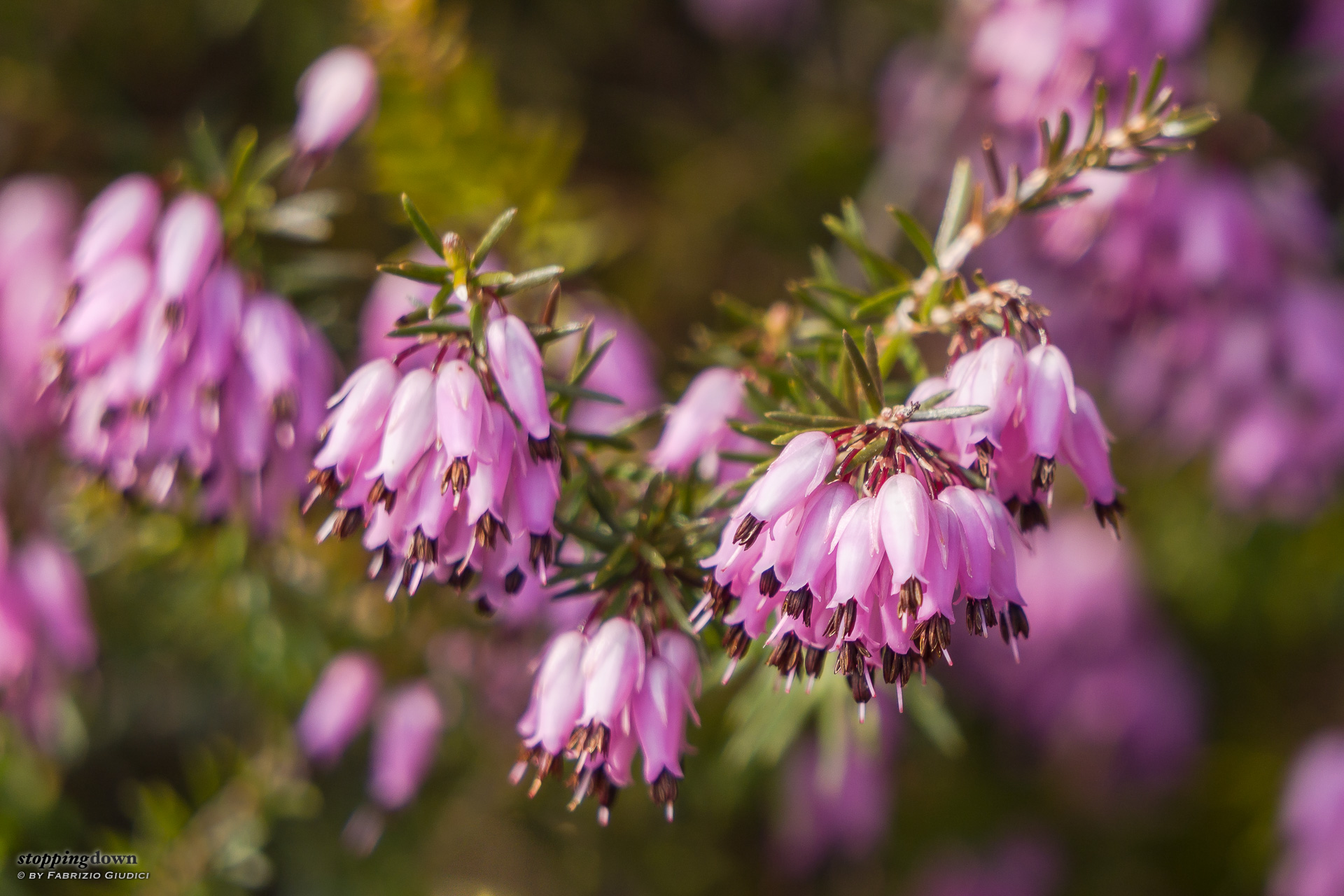Spring is here again, with its load of blossoming flowers. And this year I've learned a number of new places near home where there is plenty of flowers, so I can start practising early, instead of waiting for my summer journeys in the Alps. Actually, I was surprised by the number of different species I could easily find — and in couple of days I think I've doubled the species I can identify. I have to practice a lot with flowers: both in composition and technique, since focusing in macro-mode is not easy. This year, hopefully, I'll be able to have several flower shooting sessions, so I can learn quickly from my errors.
Sony α6000 + Sony FE 70-200mm F4 G OSS @ 200 mm, 1/200 sec @ ƒ/4, -0.70 EV, ISO 100, extension tubes
Erica carnicina (Erica carnea).
Sony NEX-6 + Meyer-Optik Görlitz Trioplan 100mm ƒ/2.8 @ 100 mm, 1/2500 sec @ ƒ/2.8, -0.30 EV, ISO 200, extension tubes, Kirk Enterprises Window Mount from the car.
Primule comuni (Primula vulgaris).
Sony α6000 + Sony FE 70-200mm F4 G OSS @ 120 mm, 1/250 sec @ ƒ/4, +0.30 EV, ISO 100, extension tubes
Zafferano trascurato (Crocus neglectus).
At the moment I own three lenses suitable for flowers. In the past, I got some decent results with the Nikkor 300mm ƒ/4D ED-IF AF-S, but I have a hard time with focusing it: the Nikon D7000 has a too large AF sensor for precisely putting the spot upon stamens and pistils at maximum aperture, and I'm not comfortable with manual focusing by means of an optical viewfinder. With the Sony electronic viewfinder manual focusing is definitely easier, so I can use the Trioplan for soft images. It's probably the best lens for flowers, thanks also to its wide maximum aperture.
Sony α6000 + Meyer-Optik Görlitz Trioplan 100mm ƒ/2.8 @ 100 mm, 1/320 sec @ ƒ/2.8, +0.70 EV, ISO 200, extension tubes
Scilla silvestre (Scilla bifolia).
Sony α6000 + Meyer-Optik Görlitz Trioplan 100mm ƒ/2.8 @ 100 mm, 1/500 sec @ ƒ/2.8, +0.70 EV, ISO 200, extension tubes
Polmonaria maggiore (Pulmunaria officinalis).
Sony α6000 + Meyer-Optik Görlitz Trioplan 100mm ƒ/2.8 @ 100 mm, 1/320 sec @ ƒ/2.8, +0.30 EV, ISO 200, extension tubes, hand-held, cropped.
Erba trinità (Hepatica nobilis).
Last but not least, I've bought a couple of extension tubes for the Sony FE 70-200mm F4 G OSS, so this lens can be used too — even though its bokeh is not as creamy as the Trioplan. But the Sony α6000 can be set with a very small focusing spot, perfectly suited for flowers, so the 70-200mm can be used in autofocusing mode. I've found it's a useful feature, when there's wind and the flowers are moving, or when I'm in a hurry and I want to go hand-held — the 70-200mm is a stabilised lens.
Sony α6000 + Sony FE 70-200mm F4 G OSS @ 200 mm, 1/1000 sec @ ƒ/4, -1.70 EV, ISO 100, extension tubes, Skimmer Ground Pod II.
Bucaneve (Galanthus nivalis).
Sony α6000 + Meyer-Optik Görlitz Trioplan 100mm ƒ/2.8 @ 100 mm, 1/320 sec @ ƒ/2.8, +0.30 EV, ISO 100, extension tubes
Erba trinità (Hepatica nobilis).
Sony α6000 + Meyer-Optik Görlitz Trioplan 100mm ƒ/2.8 @ 100 mm, 1/400 sec @ ƒ/2.8, +0.70 EV, ISO 100, extension tubes, tripod
Elleboro puzzolente (Helleborus foetidus).
Stability is an area where I need lots of improvements. The tripod can't be used for the shots very low on the ground, that are fundamental to create the great amount of blur required to mask the many distracting details that are usually found near a flower (typically debris on the ground, or grass blades). Laying the camera directly on the ground, or over a beanbag, doesn't keep it steady enough — it's not a problem of motion blur, but of depth of field: the slightest shift of the camera can easily move the focused area away from where I want it. The Skimmer Ground Pod II that I use for birds makes the camera steadier, but I've found that it's often too tall and prevents from achieving the desired blur. I have to study something different.
Sony NEX-6 + Meyer-Optik Görlitz Trioplan 100mm ƒ/2.8 @ 100 mm, 1/1250 sec @ ƒ/2.8, -0.30 EV, ISO 100, extension tubes
Zafferano trascurato (Crocus neglectus).
Sony NEX-6 + Meyer-Optik Görlitz Trioplan 100mm ƒ/2.8 @ 100 mm, 1/1250 sec @ ƒ/2.8, ISO 200, extension tubes, hand-held, cropped.
Zafferano trascurato (Crocus neglectus).
Sony α6000 + Sony FE 70-200mm F4 G OSS @ 200 mm, 1/125 sec @ ƒ/4, +0.70 EV, ISO 100, extension tubes
Zafferano trascurato (Crocus neglectus).
As a final thought, I realised that I often go too close to the subject and, once I'm in position, I'm too lazy to move back. Leaving some more room around the subject can be useful for a better composition in post-processing, by means of cropping; I must admit that, so far, I'm often unable to get the best composition right in the viewfinder. In some other cases, I could create a decent shot out of an unpleasant one by means of a heavy amount of cropping — which means that sometimes I should also try to get even closer.
Sony α6000 + Meyer-Optik Görlitz Trioplan 100mm ƒ/2.8 @ 100 mm, 1/320 sec @ ƒ/2.8, +0.70 EV, ISO 100, extension tubes, tripod, heavily cropped.
Farfaraccio bianco (Petasites albus).





























